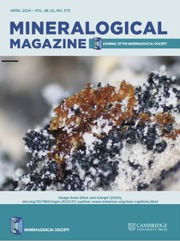Crossref Citations
This article has been cited by the following publications. This list is generated based on data provided by
Crossref.
Whittington, Alan
Harris, Nigel
and
Baker, Judy
1998.
Low-pressure crustal anatexis: the significance of spinel and cordierite from metapelitic assemblages at Nanga Parbat, northern Parkistan.
Geological Society, London, Special Publications,
Vol. 138,
Issue. 1,
p.
183.
Douce, Alberto E. Patiño
and
McCarthy, T. C.
1998.
When Continents Collide: Geodynamics and Geochemistry of Ultrahigh-Pressure Rocks.
Vol. 10,
Issue. ,
p.
27.
Whittington, A.
Harris, N. B. W.
Ayres, M. W.
and
Foster, G.
2000.
Tracing the origins of the western Himalaya: an isotopic comparison of the Nanga Parbat massif and Zanskar Himalaya.
Geological Society, London, Special Publications,
Vol. 170,
Issue. 1,
p.
201.
Butler, R. W. H.
2000.
Structural evolution of the western margin of the Nanga Parbat massif, Pakistan Himalaya: insights from the Raikhot-Liachar area.
Geological Society, London, Special Publications,
Vol. 170,
Issue. 1,
p.
51.
Treloar, P. J.
Rex, D. C.
Guise, P. G.
Wheeler, J.
Hurford, A. J.
and
Carter, A.
2000.
Geochronological constraints on the evolution of the Nanga Parbat syntaxis, Pakistan Himalaya.
Geological Society, London, Special Publications,
Vol. 170,
Issue. 1,
p.
137.
Barker
Bennett
Boyce
and
Fallick
2000.
Retrogression by deep infiltration of meteoric fluids into thrust zones during late‐orogenic rapid unroofing.
Journal of Metamorphic Geology,
Vol. 18,
Issue. 3,
p.
307.
Argles, T. W.
2000.
The evolution of the Main Mantle Thrust in the Western Syntaxis, Northern Pakistan.
Geological Society, London, Special Publications,
Vol. 170,
Issue. 1,
p.
101.
Butler, R. W. H.
Wheeler, J.
Treloar, P. J.
and
Jones, C.
2000.
Geological structure of the southern part of the Nanga Parbat massif, Pakistan Himalaya, and its tectonic implications.
Geological Society, London, Special Publications,
Vol. 170,
Issue. 1,
p.
123.
Treloar, P. J.
George, M. T.
and
Whittington, A. G.
2000.
Mafic sheets from Indian plate gneisses in the Nanga Parbat syntaxis: their significance in dating crustal growth and metamorphic and deformation events.
Geological Society, London, Special Publications,
Vol. 170,
Issue. 1,
p.
25.
PRINCE, C.
HARRIS, N.
and
VANCE, D.
2001.
Fluid-enhanced melting during prograde metamorphism.
Journal of the Geological Society,
Vol. 158,
Issue. 2,
p.
233.
Zeitler, Peter K.
Koons, Peter O.
Bishop, Michael P.
Chamberlain, C. Page
Craw, David
Edwards, Michael A.
Hamidullah, Syed
Jan, M. Qasim
Khan, M. Asif
Khattak, M. Umar Khan
Kidd, William S. F.
Mackie, Randall L.
Meltzer, Anne S.
Park, Stephen K.
Pecher, Arnaud
Poage, Michael A.
Sarker, Golam
Schneider, David A.
Seeber, Leonardo
and
Shroder, John F.
2001.
Crustal reworking at Nanga Parbat, Pakistan: Metamorphic consequences of thermal‐mechanical coupling facilitated by erosion.
Tectonics,
Vol. 20,
Issue. 5,
p.
712.
Schneider, D. A.
Zeitler, P. K.
Kidd, W. S. F.
and
Edwards, M. A.
2001.
Geochronologic Constraints on the Tectonic Evolution and Exhumation of Nanga Parbat, Western Himalaya Syntaxis, Revisited.
The Journal of Geology,
Vol. 109,
Issue. 5,
p.
563.
Lai, Shaocong
Liu, Chiyang
and
O’Reilly, S. Y.
2001.
Petrogenesis and its significance to continental dynamics of the Neogene high-potassium calc-alkaline volcanic rock association from north Qiangtang, Tibetan Plateau.
Science in China Series D: Earth Sciences,
Vol. 44,
Issue. S1,
p.
45.
ZAFAR, Mohammad
MURATA, Mamoru
ALI, Arshad
JABEEN, Iffat
KHAN, Tahseenullah
OZAWA, Hiroaki
and
NISHIMURA, Hiroshi
2001.
Oxygen isotope compositions of Miocene Garam Chashma granites, Trans-Himalayas (Hindukush Range), North Pakistan..
Journal of Mineralogical and Petrological Sciences,
Vol. 96,
Issue. 5,
p.
197.
Argles, T.W
and
Edwards, M.A
2002.
First evidence for high-grade, Himalayan-age synconvergent extension recognised within the western syntaxis—Nanga Parbat, Pakistan.
Journal of Structural Geology,
Vol. 24,
Issue. 8,
p.
1327.
Burbank, D. W.
2002.
Rates of erosion and their implications for exhumation.
Mineralogical Magazine,
Vol. 66,
Issue. 1,
p.
25.
Butler, R. W. H.
Casey, M.
Lloyd, G. E.
Bond, C. E.
McDade, P.
Shipton, Z.
and
Jones, R.
2002.
Vertical stretching and crustal thickening at Nanga Parbat, Pakistan Himalaya: A model for distributed continental deformation during mountain building.
Tectonics,
Vol. 21,
Issue. 4,
Whittington, A. G.
and
Treloar, P. J.
2002.
Crustal anatexis and its relation to the exhumation of collisional orogenic belts, with particular reference to the Himalaya.
Mineralogical Magazine,
Vol. 66,
Issue. 1,
p.
53.
Lai, Shao-Cong
Liu, Chi-Yang
and
Yi, Hai-Sheng
2003.
Geochemistry and Petrogenesis of Cenozoic Andesite-Dacite Associations from the Hoh Xil Region, Tibetan Plateau.
International Geology Review,
Vol. 45,
Issue. 11,
p.
998.
Jones, R. R.
Holdsworth, R. E.
Hand, M.
and
Goscombe, B.
2006.
Ductile extrusion in continental collision zones: ambiguities in the definition of channel flow and its identification in ancient orogens.
Geological Society, London, Special Publications,
Vol. 268,
Issue. 1,
p.
201.

